oil temperature MERCEDES-BENZ C-Class 2011 W204 Owner's Manual
[x] Cancel search | Manufacturer: MERCEDES-BENZ, Model Year: 2011, Model line: C-Class, Model: MERCEDES-BENZ C-Class 2011 W204Pages: 320, PDF Size: 13.17 MB
Page 10 of 320
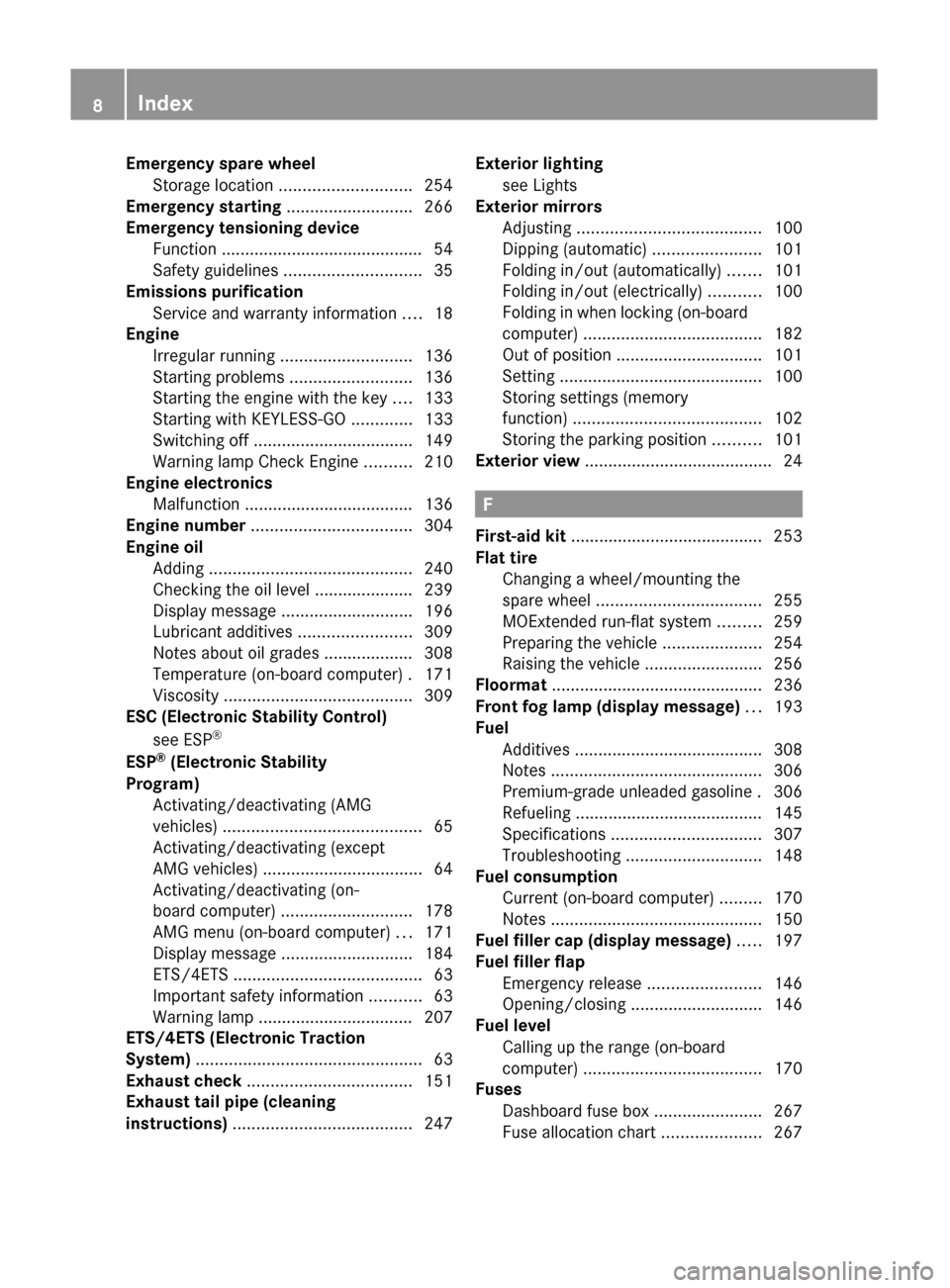
Emergency spare wheelStorage location ............................ 254
Emergency starting ........................... 266
Emergency tensioning device Function ........................................... 54
Safety guidelines ............................. 35
Emissions purification
Service and warranty information ....18
Engine
Irregular running ............................ 136
Starting problems ..........................136
Starting the engine with the key ....133
Starting with KEYLESS-GO .............133
Switching off .................................. 149
Warning lamp Check Engine ..........210
Engine electronics
Malfunction .................................... 136
Engine number .................................. 304
Engine oil Adding ........................................... 240
Checking the oil level ..................... 239
Display message ............................ 196
Lubricant additives ........................309
Notes about oil grades ................... 308
Temperature (on-board computer) . 171
Viscosity ........................................ 309
ESC (Electronic Stability Control)
see ESP ®
ESP ®
(Electronic Stability
Program) Activating/deactivating (AMG
vehicles) .......................................... 65
Activating/deactivating (except
AMG vehicles) .................................. 64
Activating/deactivating (on-
board computer) ............................ 178
AMG menu (on-board computer) ...171
Display message ............................ 184
ETS/4ETS ........................................ 63
Important safety information ...........63
Warning lamp ................................. 207
ETS/4ETS (Electronic Traction
System) ................................................ 63
Exhaust check ................................... 151
Exhaust tail pipe (cleaning
instructions) ...................................... 247Exterior lighting
see Lights
Exterior mirrors
Adjusting ....................................... 100
Dipping (automatic) .......................101
Folding in/out (automatically) .......101
Folding in/out (electrically) ...........100
Folding in when locking (on-board
computer) ...................................... 182
Out of position ............................... 101
Setting ........................................... 100
Storing settings (memory
function) ........................................ 102
Storing the parking position ..........101
Exterior view ........................................ 24
F
First-aid kit ......................................... 253
Flat tire Changing a wheel/mounting the
spare wheel ................................... 255
MOExtended run-flat system .........259
Preparing the vehicle .....................254
Raising the vehicle .........................256
Floormat ............................................. 236
Front fog lamp (display message) ... 193
Fuel Additives ........................................ 308
Notes ............................................. 306
Premium-grade unleaded gasoline . 306
Refueling ........................................ 145
Specifications ................................ 307
Troubleshooting ............................. 148
Fuel consumption
Current (on-board computer) .........170
Notes ............................................. 150
Fuel filler cap (display message) ..... 197
Fuel filler flap Emergency release ........................146
Opening/closing ............................ 146
Fuel level
Calling up the range (on-board
computer) ...................................... 170
Fuses
Dashboard fuse box .......................267
Fuse allocation chart .....................267
8IndexBA 204 USA, CA Edition A 2011; 1; 5, en-UShereepeVersion: 3.0.3.62010-05-20T09:17:30+02:00 - Seite 8
Page 13 of 320
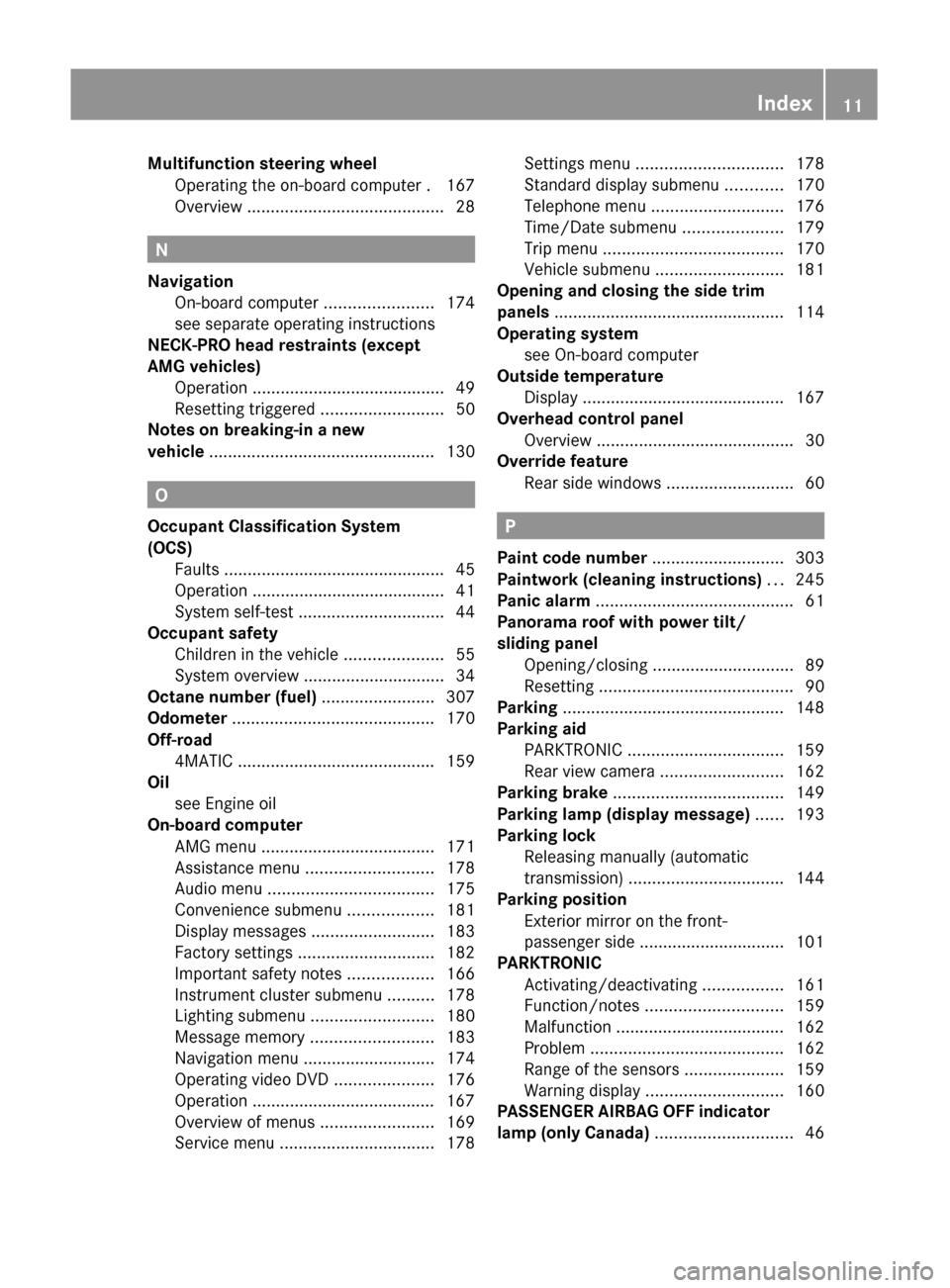
Multifunction steering wheelOperating the on-board computer . 167
Overview .......................................... 28
N
Navigation On-board computer .......................174
see separate operating instructions
NECK-PRO head restraints (except
AMG vehicles) Operation ......................................... 49
Resetting triggered ..........................50
Notes on breaking-in a new
vehicle ................................................ 130
O
Occupant Classification System
(OCS) Faults ............................................... 45
Operation ......................................... 41
System self-test ............................... 44
Occupant safety
Children in the vehicle .....................55
System overview .............................. 34
Octane number (fuel) ........................ 307
Odometer ........................................... 170
Off-road 4MATIC .......................................... 159
Oil
see Engine oil
On-board computer
AMG menu ..................................... 171
Assistance menu ........................... 178
Audio menu ................................... 175
Convenience submenu ..................181
Display messages ..........................183
Factory settings ............................. 182
Important safety notes ..................166
Instrument cluster submenu ..........178
Lighting submenu .......................... 180
Message memory .......................... 183
Navigation menu ............................ 174
Operating video DVD .....................176
Operation ....................................... 167
Overview of menus ........................169
Service menu ................................. 178
Settings menu ............................... 178
Standard display submenu ............170
Telephone menu ............................ 176
Time/Date submenu .....................179
Trip menu ...................................... 170
Vehicle submenu ........................... 181
Opening and closing the side trim
panels ................................................. 114
Operating system see On-board computer
Outside temperature
Display ........................................... 167
Overhead control panel
Overview .......................................... 30
Override feature
Rear side windows ...........................60
P
Paint code number ............................ 303
Paintwork (cleaning instructions) ... 245
Panic alarm .......................................... 61
Panorama roof with power tilt/
sliding panel Opening/closing .............................. 89
Resetting ......................................... 90
Parking ............................................... 148
Parking aid PARKTRONIC ................................. 159
Rear view camera .......................... 162
Parking brake .................................... 149
Parking lamp (display message) ...... 193
Parking lock Releasing manually (automatic
transmission) ................................. 144
Parking position
Exterior mirror on the front-
passenger side ............................... 101
PARKTRONIC
Activating/deactivating .................161
Function/notes ............................. 159
Malfunction .................................... 162
Problem ......................................... 162
Range of the sensors .....................159
Warning display ............................. 160
PASSENGER AIRBAG OFF indicator
lamp (only Canada) ............................. 46
Index11BA 204 USA, CA Edition A 2011; 1; 5, en-UShereepeVersion: 3.0.3.62010-05-20T09:17:30+02:00 - Seite 11
Page 17 of 320

Engine oil (on-board computer) ...... 171
Outside temperature ...................... 167
Setting ........................................... 123
Theft deterrent locking system
Immobilizer ...................................... 66
Through-loading feature ................... 218
Tilt/sliding sunroof Opening/closing .............................. 88
Resetting ......................................... 88
Time (on-board computer) ................ 179
Timer (on-board computer) .............. 172
Tire pressure Calling up (on-board computer) .....277
Checking manually ........................275
Display message ............................ 197
Maximum ....................................... 280
Notes ............................................. 273
Pressure loss warning ....................275
Recommended ............................... 272
Tire pressure monitoring system
Function/notes ............................. 277
Restarting ...................................... 279
Warning lamp ................................. 212
Tires
Aspect ratio (definition) .................292
Average weight of the vehicle
occupants (definition) ....................290
Bar (definition) ............................... 290
Characteristics .............................. 290
Checking ........................................ 271
Cleaning ......................................... 272
Definition of terms .........................290
Direction of rotation ......................284
Distribution of the vehicle
occupants (definition) ....................293
DOT, Tire Identification Number
(TIN) ............................................... 289
DOT (Department of
Transportation) (definition) ............290
Flat tire .......................................... 254
GAWR (Gross Axle Weight Rating)
(definition) ..................................... 291
Guidelines to be observed .............271
GVW (Gross Vehicle Weight)
(definition) ..................................... 291
GVWR (Gross Vehicle Weight
Rating) (definition) .........................291Increased vehicle weight due to
optional equipment (definition) ......291
Kilopascal (kPa) (definition) ...........291
Labeling (overview) ........................286
Load bearing index (definition) ......292
Load index ..................................... 289
Load index (definition) ...................291
Maximum loaded vehicle weight
(definition) ..................................... 291
Maximum load on a tire
(definition) ..................................... 292
Maximum permissible tire
pressure (definition) ....................... 292
Maximum tire load .........................284
Maximum tire load (definition) .......291
Optional equipment weight
(definition) ..................................... 292
PSI (pounds per square inch)
(definition) ..................................... 292
Replacing ....................................... 286
Service life ..................................... 271
Sidewall (definition) .......................292
Speed index (definition) .................291
Storing ........................................... 272
Structure and characteristics
(definition) ..................................... 290
Temperature .................................. 285
TIN (Tire Identification Number)
(definition) ..................................... 292
Tire bead (definition) ......................292
Tire pressure (definition) ................292
Tire pressures (recommended) ......290
Tire size (data) ............................... 293
Tire size designation, load-bearing
capacity, speed index ....................287
Tire tread ....................................... 271
Tire tread (definition) .....................292
Total load limit (definition) .............293
Traction ......................................... 285
Traction (definition) .......................292
Tread wear ..................................... 285
Uniform Tire Quality Grading
Standards ...................................... 284
Uniform Tire Quality Grading
Standards (definition) ....................290
Unladen weight (definition) ............291
Wear indicator (definition) .............292
Wheel rim (definition) ....................291Index15BA 204 USA, CA Edition A 2011; 1; 5, en-UShereepeVersion: 3.0.3.62010-05-20T09:17:30+02:00 - Seite 15
Page 133 of 320
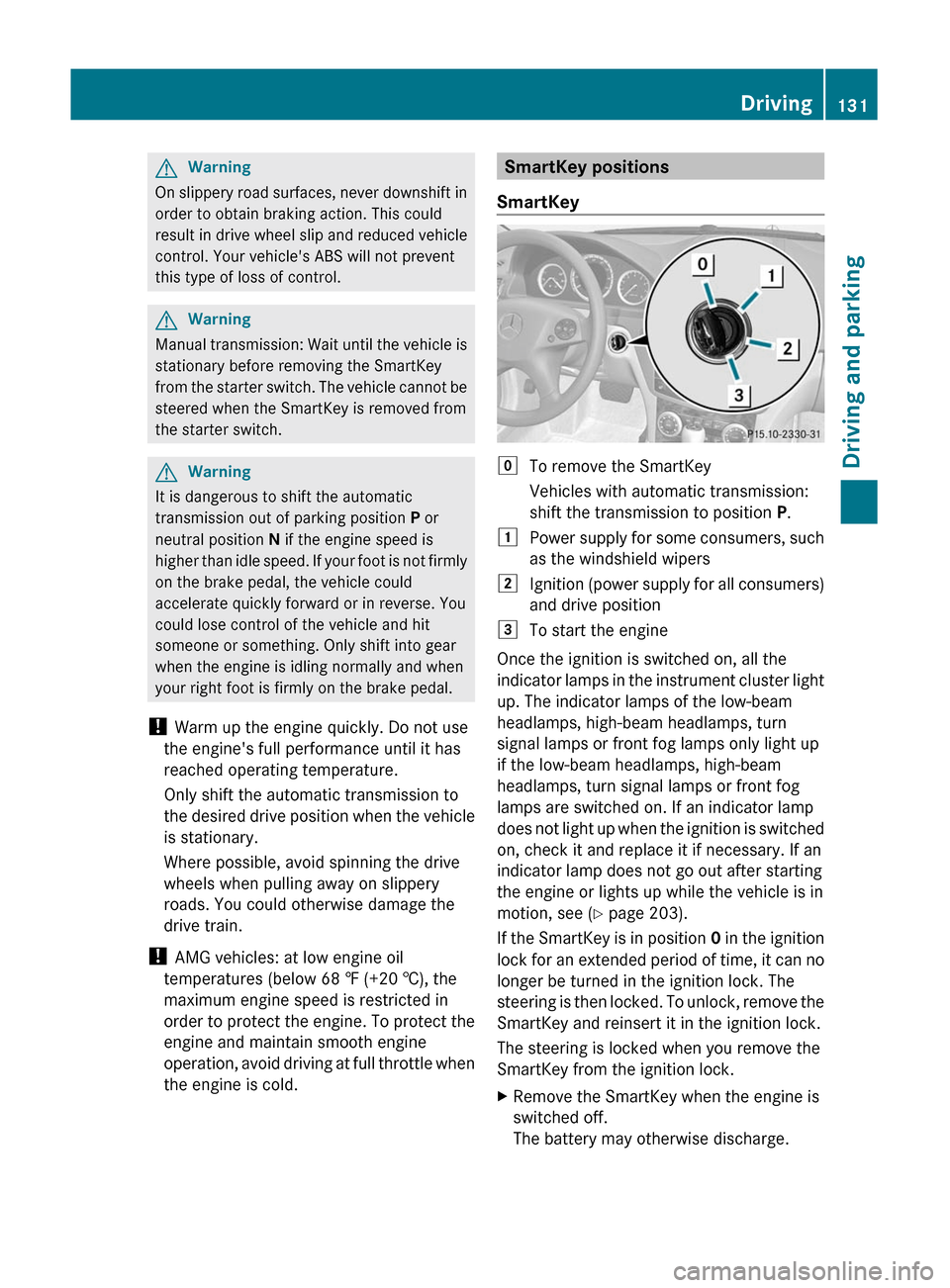
GWarning
On slippery road surfaces, never downshift in
order to obtain braking action. This could
result in drive wheel slip and reduced vehicle
control. Your vehicle's ABS will not prevent
this type of loss of control.
GWarning
Manual transmission: Wait until the vehicle is
stationary before removing the SmartKey
from the starter switch. The vehicle cannot be
steered when the SmartKey is removed from
the starter switch.
GWarning
It is dangerous to shift the automatic
transmission out of parking position P or
neutral position N if the engine speed is
higher than idle speed. If your foot is not firmly
on the brake pedal, the vehicle could
accelerate quickly forward or in reverse. You
could lose control of the vehicle and hit
someone or something. Only shift into gear
when the engine is idling normally and when
your right foot is firmly on the brake pedal.
! Warm up the engine quickly. Do not use
the engine's full performance until it has
reached operating temperature.
Only shift the automatic transmission to
the desired drive position when the vehicle
is stationary.
Where possible, avoid spinning the drive
wheels when pulling away on slippery
roads. You could otherwise damage the
drive train.
! AMG vehicles: at low engine oil
temperatures (below 68 ‡ (+20 †), the
maximum engine speed is restricted in
order to protect the engine. To protect the
engine and maintain smooth engine
operation, avoid driving at full throttle when
the engine is cold.
SmartKey positions
SmartKeygTo remove the SmartKey
Vehicles with automatic transmission:
shift the transmission to position P.1Power supply for some consumers, such
as the windshield wipers2Ignition (power supply for all consumers)
and drive position3To start the engine
Once the ignition is switched on, all the
indicator lamps in the instrument cluster light
up. The indicator lamps of the low-beam
headlamps, high-beam headlamps, turn
signal lamps or front fog lamps only light up
if the low-beam headlamps, high-beam
headlamps, turn signal lamps or front fog
lamps are switched on. If an indicator lamp
does not light up when the ignition is switched
on, check it and replace it if necessary. If an
indicator lamp does not go out after starting
the engine or lights up while the vehicle is in
motion, see ( Y page 203).
If the SmartKey is in position 0 in the ignition
lock for an extended period of time, it can no
longer be turned in the ignition lock. The
steering is then locked. To unlock, remove the
SmartKey and reinsert it in the ignition lock.
The steering is locked when you remove the
SmartKey from the ignition lock.
XRemove the SmartKey when the engine is
switched off.
The battery may otherwise discharge.Driving131Driving and parkingBA 204 USA, CA Edition A 2011; 1; 5, en-UShereepeVersion: 3.0.3.62010-05-20T09:17:30+02:00 - Seite 131Z
Page 173 of 320
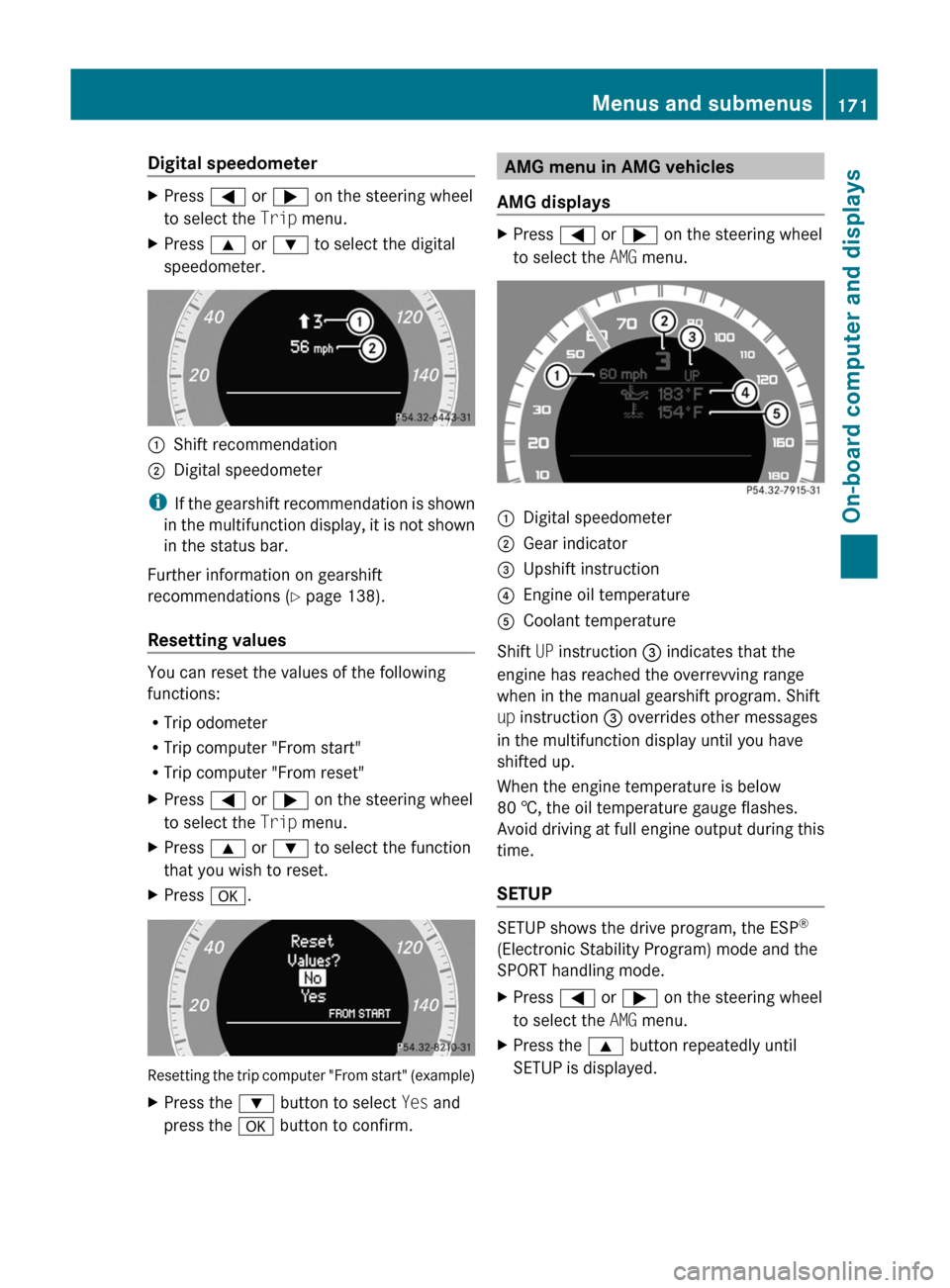
Digital speedometerXPress = or ; on the steering wheel
to select the Trip menu. XPress 9 or : to select the digital
speedometer.:Shift recommendation;Digital speedometer
i If the gearshift recommendation is shown
in the multifunction display, it is not shown
in the status bar.
Further information on gearshift
recommendations ( Y page 138).
Resetting values
You can reset the values of the following
functions:
R Trip odometer
R Trip computer "From start"
R Trip computer "From reset"
XPress = or ; on the steering wheel
to select the Trip menu. XPress 9 or : to select the function
that you wish to reset.XPress a.
Resetting the trip computer "From start" (example)
XPress the : button to select Yes and
press the a button to confirm.AMG menu in AMG vehicles
AMG displaysXPress = or ; on the steering wheel
to select the AMG menu. :Digital speedometer;Gear indicator=Upshift instruction?Engine oil temperatureACoolant temperature
Shift UP instruction = indicates that the
engine has reached the overrevving range
when in the manual gearshift program. Shift
up instruction = overrides other messages
in the multifunction display until you have
shifted up.
When the engine temperature is below
80 †, the oil temperature gauge flashes.
Avoid driving at full engine output during this
time.
SETUP
SETUP shows the drive program, the ESP ®
(Electronic Stability Program) mode and the
SPORT handling mode.
XPress = or ; on the steering wheel
to select the AMG menu.XPress the 9 button repeatedly until
SETUP is displayed.Menus and submenus171On-board computer and displaysBA 204 USA, CA Edition A 2011; 1; 5, en-UShereepeVersion: 3.0.3.62010-05-20T09:17:30+02:00 - Seite 171Z
Page 198 of 320
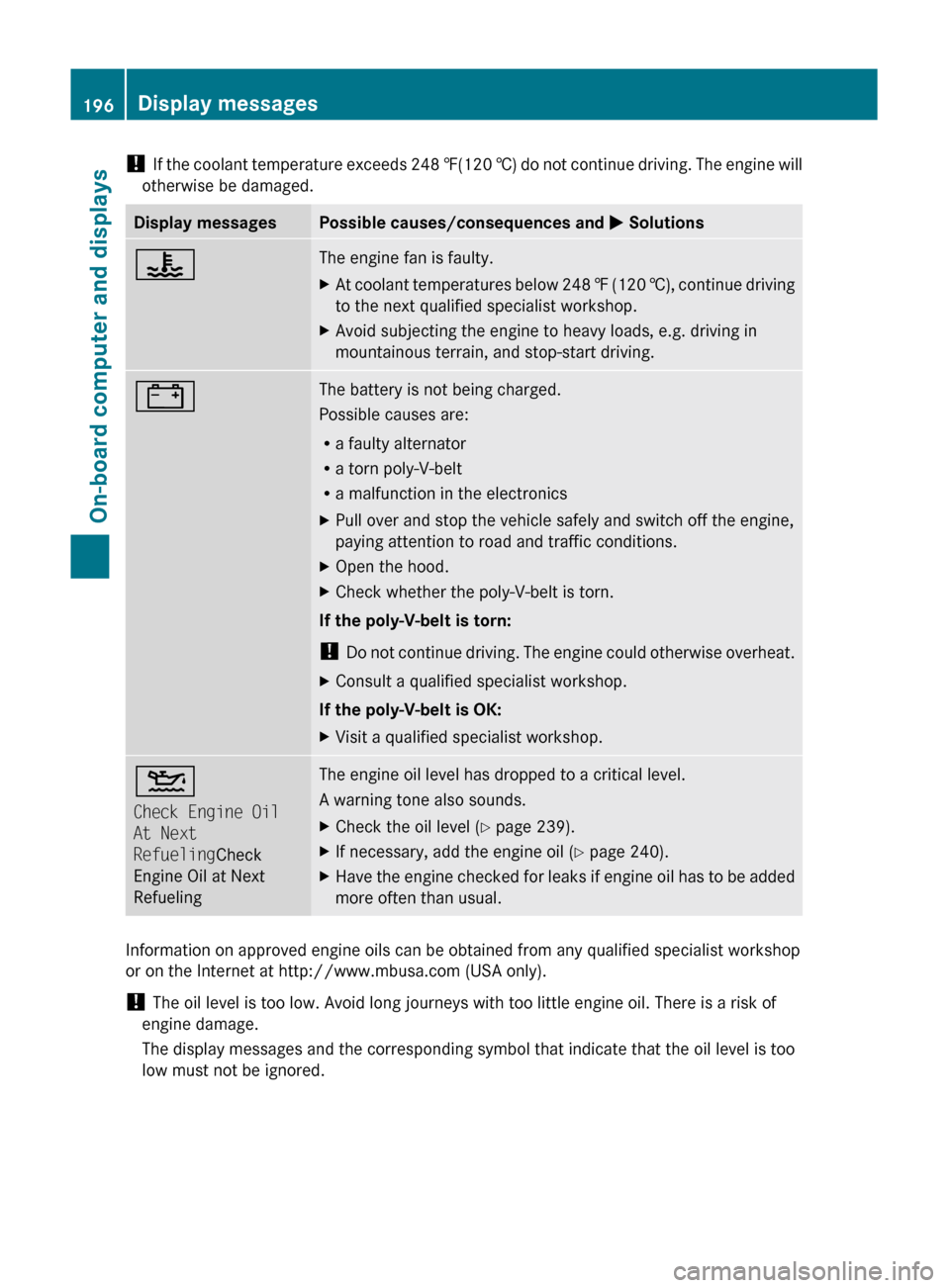
! If the coolant temperature exceeds 248 ‡(120 †) do not continue driving. The engine will
otherwise be damaged.Display messagesPossible causes/consequences and M Solutions?The engine fan is faulty.XAt coolant temperatures below 248 ‡ (120 †), continue driving
to the next qualified specialist workshop.XAvoid subjecting the engine to heavy loads, e.g. driving in
mountainous terrain, and stop-start driving.#The battery is not being charged.
Possible causes are:
R a faulty alternator
R a torn poly-V-belt
R a malfunction in the electronicsXPull over and stop the vehicle safely and switch off the engine,
paying attention to road and traffic conditions.XOpen the hood.XCheck whether the poly-V-belt is torn.
If the poly-V-belt is torn:
! Do not continue driving. The engine could otherwise overheat.
XConsult a qualified specialist workshop.
If the poly-V-belt is OK:
XVisit a qualified specialist workshop.4
Check Engine Oil
At Next
Refueling Check
Engine Oil at Next
RefuelingThe engine oil level has dropped to a critical level.
A warning tone also sounds.XCheck the oil level ( Y page 239).XIf necessary, add the engine oil ( Y page 240).XHave the engine checked for leaks if engine oil has to be added
more often than usual.
Information on approved engine oils can be obtained from any qualified specialist workshop
or on the Internet at http://www.mbusa.com (USA only).
! The oil level is too low. Avoid long journeys with too little engine oil. There is a risk of
engine damage.
The display messages and the corresponding symbol that indicate that the oil level is too
low must not be ignored.
196Display messagesOn-board computer and displays
BA 204 USA, CA Edition A 2011; 1; 5, en-UShereepeVersion: 3.0.3.62010-05-20T09:17:30+02:00 - Seite 196
Page 240 of 320
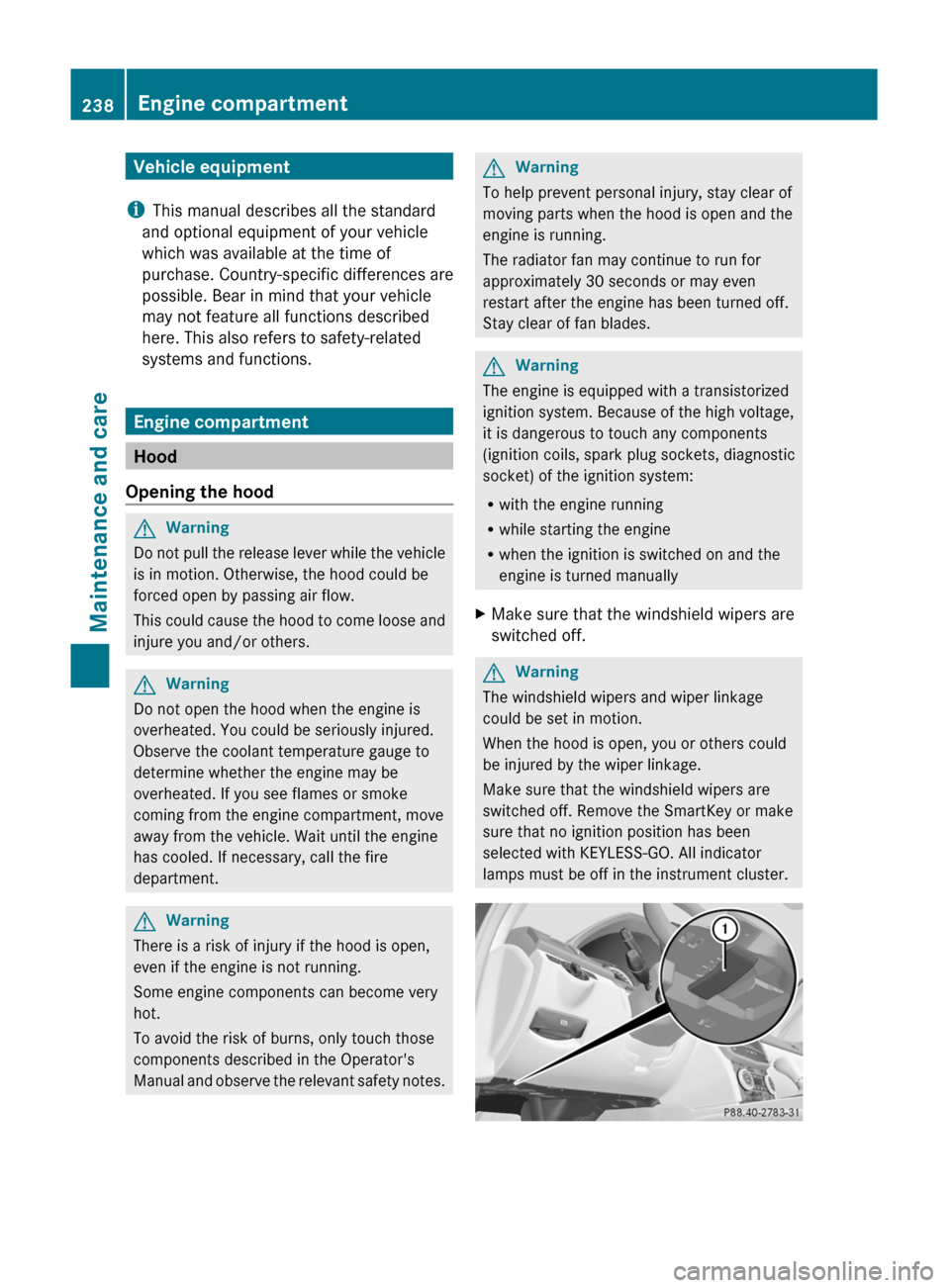
Vehicle equipment
iThis manual describes all the standard
and optional equipment of your vehicle
which was available at the time of
purchase. Country-specific differences are
possible. Bear in mind that your vehicle
may not feature all functions described
here. This also refers to safety-related
systems and functions.
Engine compartment
Hood
Opening the hood
GWarning
Do not pull the release lever while the vehicle
is in motion. Otherwise, the hood could be
forced open by passing air flow.
This could cause the hood to come loose and
injure you and/or others.
GWarning
Do not open the hood when the engine is
overheated. You could be seriously injured.
Observe the coolant temperature gauge to
determine whether the engine may be
overheated. If you see flames or smoke
coming from the engine compartment, move
away from the vehicle. Wait until the engine
has cooled. If necessary, call the fire
department.
GWarning
There is a risk of injury if the hood is open,
even if the engine is not running.
Some engine components can become very
hot.
To avoid the risk of burns, only touch those
components described in the Operator's
Manual and observe the relevant safety notes.
GWarning
To help prevent personal injury, stay clear of
moving parts when the hood is open and the
engine is running.
The radiator fan may continue to run for
approximately 30 seconds or may even
restart after the engine has been turned off.
Stay clear of fan blades.
GWarning
The engine is equipped with a transistorized
ignition system. Because of the high voltage,
it is dangerous to touch any components
(ignition coils, spark plug sockets, diagnostic
socket) of the ignition system:
Rwith the engine running
Rwhile starting the engine
Rwhen the ignition is switched on and the
engine is turned manually
XMake sure that the windshield wipers are
switched off.
GWarning
The windshield wipers and wiper linkage
could be set in motion.
When the hood is open, you or others could
be injured by the wiper linkage.
Make sure that the windshield wipers are
switched off. Remove the SmartKey or make
sure that no ignition position has been
selected with KEYLESS-GO. All indicator
lamps must be off in the instrument cluster.
238Engine compartmentMaintenance and care
BA 204 USA, CA Edition A 2011; 1; 5, en-UShereepeVersion: 3.0.3.62010-05-20T09:17:30+02:00 - Seite 238
Page 241 of 320

XPull release lever : on the hood.
The hood is released.
! Make sure that the windshield wipers are
not folded away from the windshield. You
could otherwise damage the windshield
wipers or the hood.
XReach into the gap, pull hood catch
handle ; up and lift the hood.
Closing the hood
GWarning
When closing the hood, use extreme caution
not to catch hands or fingers. Be careful that
you do not close the hood on anyone.
Make sure the hood is securely engaged
before driving off. Do not continue driving if
the hood can no longer engage after an
accident, for example. The hood could
otherwise come loose while the vehicle is in
motion and injure you and/or others.
XLower the hood and let it fall from a height
of approximately 8 inches (20 cm).
XCheck that the hood has engaged properly.
If the hood can be raised slightly, it is not
properly engaged. Open it again and close
it with a little more force.
Engine oil
Notes on the oil level
Depending on the driving style, the vehicle
consumes up to 0.9 US qt (0.8 l) of oil over a
distance of 600 miles (1000 km). The oil
consumption may be higher than this when
the vehicle is new or if you frequently drive at
high engine speeds.
When checking the oil level:
Rpark the vehicle on a level surface.
Rthe engine should be switched off for at
least five minutes if the engine is at normal
operating temperature.
Rthe engine should be switched off for at
least 30 minutes if it is not at normal
operating temperature (i.e. if you only start
the engine briefly).
Checking the oil level using the oil
dipstick
XPull oil dipstick : out of the dipstick guide
tube.
XWipe off oil dipstick :.XSlowly insert oil dipstick : into the
dipstick guide tube to the stop, and take it
out again.
The oil level is correct if the level is between
MIN mark = and MAX mark ;.
XAdd oil if necessary.Engine compartment239Maintenance and careBA 204 USA, CA Edition A 2011; 1; 5, en-UShereepeVersion: 3.0.3.62010-05-20T09:17:30+02:00 - Seite 239Z
Page 311 of 320

ModelEngine
modelMB
ApprovalC 350272229.5C 350 4MATIC 48272229.5C 63 AMG156229.549
i
MB Approval is stated on the containers.
Lubricant additives
! Do not mix any lubricant additives with
the engine oil. This could damage the
engine. Damage resulting from the use of
such lubricant additives in the engine oil is
not covered by the Mercedes-Benz Limited
Warranty.
Engine oil viscosity
Viscosity describes the flow characteristics
of a fluid. If an engine oil has a high viscosity,
this means that it is thick; a low viscosity
means that it is thin.
Using the table below, make sure that the SAE
classification (viscosity) is sufficient for the
temperatures at which the vehicle is
operated. The low temperature
characteristics of engine oils can deteriorate
significantly, e.g. by aging, soot and fuel
deposits. It is therefore recommended that
you carry out oil changes regularly using an
approved engine oil with the appropriate SAE
classification.
Refrigerant of the air-conditioning
system
The air-conditioning system is filled with
R134a refrigerant and a special PAG
lubricant.
! Never use refrigerant R 12 (CFC) or
mineral lubricants. Otherwise, you could
damage the air-conditioning system.
Brake fluid
GWarning!
The brake fluid constantly absorbs moisture
from the air; this lowers its boiling point.
If the boiling point of the brake fluid is too low,
vapor pockets may form in the brake system
when the brakes are applied hard (e.g. when
driving downhill). This would impair braking
efficiency.
You should have the brake fluid renewed at
regular intervals. The brake fluid change
intervals can be found in the Service Booklet.
Only use brake fluid approved by Mercedes-
Benz. Information about approved brake
fluids can be obtained from any authorized
Mercedes-Benz Center.
48 Canada only.
49 Restriction: only SAE 0W-40 or SAE 5W-40 engine oils may be used.Service products and capacities309Technical dataBA 204 USA, CA Edition A 2011; 1; 5, en-UShereepeVersion: 3.0.3.62010-05-20T09:17:30+02:00 - Seite 309Z
Page 312 of 320

Coolant
Important safety notes
The coolant is a mixture of water and
antifreeze/corrosion inhibitor. It performs
the following tasks:
R anti-corrosion protection
R antifreeze protection
R raising the boiling point
The cooling system is filled with coolant at the
factory which contains antifreeze/corrosion
inhibitor that ensures protection down to
approximately -35 ‡ (-37 †).
! Only add coolant that has been premixed
with the desired antifreeze protection. You
could otherwise damage the engine.
Further information on coolants and on
filling can be found in the Mercedes-Benz
Specifications for Service Products, MB
Approval 310.1, e.g. on the Internet at
http://bevo.mercedes-benz.com . You
can also consult an authorized Mercedes-
Benz Center.
! Always use a suitable coolant mixture,
even in countries where high temperatures
prevail.
Otherwise, the cooling system will not be
sufficiently protected from corrosion, and
the boiling point will be too low.
If the coolant has antifreeze protection down
to -35 ‡ (-37 †), the boiling point of the
coolant in the pressurized system is
approximately 266 ‡ (130 †).
Your vehicle has a range of aluminum
components. Use of aluminum components
in the engine make it necessary to specifically
match the antifreeze/corrosion inhibitor in
these systems in order to protect the
aluminum parts. Using other antifreeze/
corrosion inhibitors without these
characteristics affects the service life.
The coolant must be used throughout the year
in order to maintain the necessary corrosion
protection and provide protection from
overheating. In the Service Booklet, you can
find information on the intervals for renewal.
The renewal interval is determined by the
coolant type and the cooling system design.
The renewal interval in the Service Booklet is
only valid if the coolant is added or renewed
with Mercedes-Benz approved products.
Therefore, only use MB 326.0 antifreeze/
corrosion inhibitor or another Mercedes-Benz
approved product of the same specification.
Information on other Mercedes-Benz
approved products of the same specification
can be obtained at any authorized Mercedes-
Benz Center or on the Internet at
http://bevo.mercedes-benz.com .
The coolant is checked at every service date
at an authorized Mercedes-Benz Center.
The antifreeze/corrosion inhibitor
concentration in the cooling system should:
R be at least 50%. This will protect the cooling
system against freezing down to around
-35 ‡ (-37 †).
R not exceed 55% (antifreeze protection
down to -49 ‡ (-45 †); otherwise, heat will
not be dissipated as effectively.
If the coolant level is too low, MB 326.0
antifreeze/corrosion inhibitor should be
added. Have the cooling system checked for
leaks.
Windshield and headlamp cleaning
system
GWarning
Washer solvent/antifreeze is highly
flammable. Do not spill washer solvent/
antifreeze on hot engine parts, because it may
ignite and burn. You could be seriously
burned.
XUse MB Windshield Washer Concentrate
MB SummerFit.XAt temperatures above freezing: add 1
part MB SummerFit to 100 parts water, e.g.310Service products and capacitiesTechnical data
BA 204 USA, CA Edition A 2011; 1; 5, en-UShereepeVersion: 3.0.3.62010-05-20T09:17:30+02:00 - Seite 310